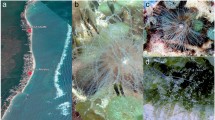Abstract
The blocking action ofNephila clavata spider neurotoxin, or JSTX, on ionic currents activated by L-glutamate and its agonists when applied to the membrane of neurons isolated from the rat hippocampus was investigated using a concentration clamp technique. Crude JSTX venom was found to block L-glutamate-, quisqualate, and kainate-activated ionic currents induced by activating non-N-methyl-D-aspartate (non-NMDA) membrane receptors. Following the effects of JSTX, ionic currents activated by L-glutamate and its agonists declined to 34–36% of their initial value with no recovery during JSTX washout. An active fraction of JSTX at concentrations of 10−4–10−5 produced almost total but partially reversible blockade of ionic currents. The action of JSTX became less effective during depolarization. The concentration dependence of JSTX-induced blockade of kainate-activated ionic currents was investigated and the velocity constants of interaction between the toxin and glutamate receptors obtained. It is postulated that JSTX interacts with chemically-operated non-NMDA ionic channels, blocking their transition into a number of their possible open states.
Similar content being viewed by others
Literature cited
N. I. Kiskin, O. A. Kryshtal', and A. Ya. Tsyndrenko, "Excitatory aminoacid receptors at the membrane of pyramidal neurons of the hippocampus," Byul. Membrany,3, No. 9, 909–919 (1986).
E. M. Klyuchko and A. Ya. Tsyndrenko, "Enzymatic isolation of pyramidal neurons from the rat hippocampus," Fiziol. Zh.,33, No. 2, 115–119 (1987).
L. G. Magazanik, S. M. Antonov, I. M. Fedorova, et al., "Action ofArgiope lobata spider venom and argiopin, its low-molecular component, on postsynaptic membranes," Byul. Membrany,3, No. 12, 1204–1219 (1986).
T. Abe, N. Kawai, and A. Miwa, "Effects of spider toxin on the glutaminergic synapse of lobster muscle," J. Physiol.,339, 243–252 (1983).
Y. Aramaki, T. Yasuhara, T. Higashijima, et al., "Chemical characterization of spider toxin, JSTX and NSTX," Proc. Jpn. Acad., Ser. B.,62, No. 9, 359–362 (1986).
G. L. Collingridge, S. J. Kehl, and H. McLennan, "Excitatory amino acids in synaptic transmission in the Schaffer collateral-commissural pathway of the rat hippocampus," J. Physiol.,334, 33–46 (1983).
C. E. Jahr and C. F. Stevens, "Glutamate activates multiple single channel conductances in hippocampal neurons," Nature,325, No. 6102, 522–525 (1987).
N. Kawai, A. Miwa, M. Saito, et al., "Spider toxin (JSTX) on the glutamate synapse," J. Physiol.,79, No. 4, 228–231 (1984).
N. Kawai, S. Yamagishi, M. Saito, and K. Furuya, "Blockage of synaptic transmission in the squid giant synapse by a spider toxin (JSTX)," Brain Res.,278, No. 2, 346–349 (1983).
N. I. Kiskin, O. A. Krishtal, and A. Ya. Tsyndrenko, "Excitatory amino acid receptors in hippocampal neurons: kainate fails to desensitize them," Neurosci. Lett.,63, No. 3, 225–230 (1986).
M. L. Mayer, "Two channels reduced to one," Nature,326, No. 6102, 480–481 (1987).
H. McLennan, "Receptors for the excitatory amino acids in the mammalian central nervous system," Prog. Neurobiol.,20, No. 6, 251–271 (1983).
M. Saito, N. Kawai, A. Miwa, et al., "Spider toxin (JSTX) blocks glutamate synapse in hippocampal pyramidal neurons," Brain Res.,346, No. 2, 397–399 (1985).
R. A. Shiels and G. Falk, "Joro spider venom: glutamate agonist and antagonist on the rod retina of the dogfish," Neurosci Lett.,77, No. 2, 221–225 (1987).
J. C. Watkins and R. H. Evans, "Excitatory amino acid transmitters," Annu. Rev. Pharmacol. Toxicol.,21, No. 3, 165–204 (1981).
Additional information
A. A. Bogomolets Institute of Physiology, Academy of Sciences of the Ukrainian SSR, Kiev. Translated from Neirofiziologiya, Vol. 21, No. 2, pp. 152–160, March–April, 1989.
Rights and permissions
About this article
Cite this article
Kiskin, N.I., Klyuchko, E.M., Kryshtal', O.A. et al. Blocking action of Nephila clavata spider toxin on ionic currents activated by glutamate and its agonists in isolated hippocampal neurons. Neurophysiology 21, 110–116 (1989). https://doi.org/10.1007/BF01056967
Received:
Issue Date:
DOI: https://doi.org/10.1007/BF01056967




